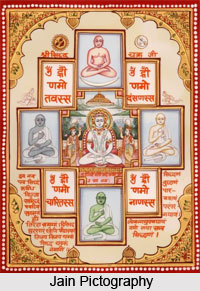 The canon of the Jains was faithfully preserved by the leaders of the community among the first followers of Lord Mahavira. However, the parts of the canon fell into disarray with the time a council was called around 300 B.C in Pataliputra according to the tradition of Swetambaras, to put together the canon anew. It was found in it that the last of the great Holy Scriptures, the so called 12th Anga which comprised the 14 works called Purva, were not any more in an authentic tradition. Since Bhadrabahu who was absent knew this completely, the community sent to him two monks who should prompt him to appear. Bhadrabahu who was then in Nepal where he had carried out a twelve-year penitential vow, said that he was not in a position to go over to Pataliputra, but was ready then and there to teach the Purvas to the pupils. Sthulabhadra was, therefore, instructed along with 500 monks to learn Purvas from him. The canon remained incomplete in spite of the efforts put on it. This lasted in an incomplete form for seven generations of teachers after Sthulabhadra, but then the knowledge of the 10 purvas was completely lost. But the remaining holy work` were preserved and they were finally edited in the council of Valabhi in the year 980 after Mahavira under the leadership of Devaradhi and first time put down in script.
The canon of the Jains was faithfully preserved by the leaders of the community among the first followers of Lord Mahavira. However, the parts of the canon fell into disarray with the time a council was called around 300 B.C in Pataliputra according to the tradition of Swetambaras, to put together the canon anew. It was found in it that the last of the great Holy Scriptures, the so called 12th Anga which comprised the 14 works called Purva, were not any more in an authentic tradition. Since Bhadrabahu who was absent knew this completely, the community sent to him two monks who should prompt him to appear. Bhadrabahu who was then in Nepal where he had carried out a twelve-year penitential vow, said that he was not in a position to go over to Pataliputra, but was ready then and there to teach the Purvas to the pupils. Sthulabhadra was, therefore, instructed along with 500 monks to learn Purvas from him. The canon remained incomplete in spite of the efforts put on it. This lasted in an incomplete form for seven generations of teachers after Sthulabhadra, but then the knowledge of the 10 purvas was completely lost. But the remaining holy work` were preserved and they were finally edited in the council of Valabhi in the year 980 after Mahavira under the leadership of Devaradhi and first time put down in script.
The cannon of Swetambaras of today are, according to their opinion the corpus of work which was fixed at that time. Digambaras agree with Swetambaras that Bhadrabahu is considered to be the last teacher of 14 Purvas. But according, to them, the genuine canon is also forgotten like the 12th Anga with its 14 Purvas in the future. Eleven generations after Bhadrabahu knew 11 Angas and 10 purvas the next five, only 11 Angas and finally four, only 1 Anga, the Achararnga.
While, thus, Swetambaras boast to possess even today the genuine canon, albeit in incomplete form, Digambaras were of the view that the canon is lost once for all that the holy scriptures of Swetambaras are not genuine; a collection of books written in a later period serve them as a guiding principle of their faith. They can be regarded as a "secondary canon" in view of the authority they enjoy.



















